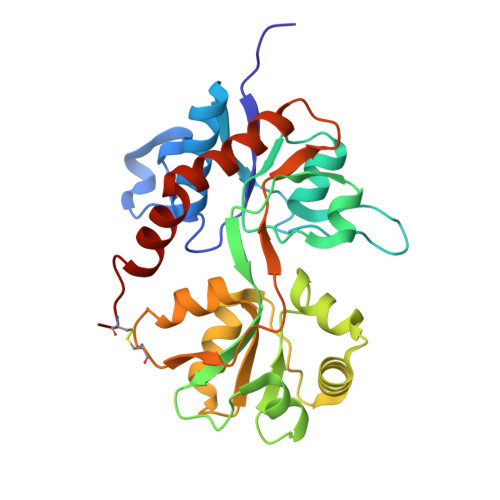A Binding Site Tyrosine Shapes Desensitization Kinetics and Agonist Potency at GluR2: a mutagenic, kinetic, and crystallographic study
Holm, M.M., Naur, P., Vestergaard, B., Geballe, M.T., Gajhede, M., Kastrup, J.S., Traynelis, S.F., Egebjerg, J.(2005) J Biol Chem 280: 35469-35476
- PubMed: 16103115
- DOI: https://doi.org/10.1074/jbc.M507800200
- Primary Citation of Related Structures:
2ANJ - PubMed Abstract:
Binding of an agonist to the 2-amino-3-(3-hydroxy-5-methyl-4-isoxazolyl)-propionic acid (AMPA) receptor family of the glutamate receptors (GluRs) results in rapid activation of an ion channel. Continuous application results in a non-desensitizing response for agonists like kainate, whereas most other agonists, such as the endogenous agonist (S)-glutamate, induce desensitization. We demonstrate that a highly conserved tyrosine, forming a wedge between the agonist and the N-terminal part of the bi-lobed ligand-binding site, plays a key role in the receptor kinetics as well as agonist potency and selectivity. The AMPA receptor GluR2, with mutations in Tyr-450, were expressed in Xenopus laevis oocytes and characterized in a two-electrode voltage clamp setup. The mutation GluR2(Y450A) renders the receptor highly kainate selective, and rapid application of kainate to outside-out patches induced strongly desensitizing currents. When Tyr-450 was substituted with the larger tryptophan, the (S)-glutamate desensitization is attenuated with a 10-fold increase in steady-state/peak currents (19% compared with 1.9% at the wild type). Furthermore, the tryptophan mutant was introduced into the GluR2-S1S2J ligand binding core construct and co-crystallized with kainate, and the 2.1-A x-ray structure revealed a slightly more closed ligand binding core as compared with the wild-type complex. Through genetic manipulations combined with structural and electrophysiological analysis, we report that mutations in position 450 invert the potency of two central agonists while concurrently strongly shaping the agonist efficacy and the desensitization kinetics of the AMPA receptor GluR2.
Organizational Affiliation:
Department of Molecular Biology, C. F. Møllers Allé Bldg. 130, University of Aarhus, DK-8000 Aarhus, Denmark. [email protected]















